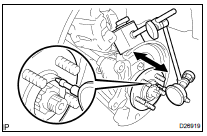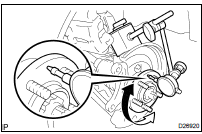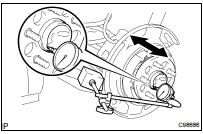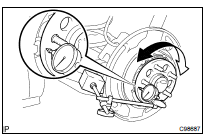Toyota Highlander Service Manual: On-vehicle inspection
1. INSPECT FRONT AXLE HUB BEARING LOOSENESS

(a) Using a dial indicator, check for looseness near the center of the axle hub.
Maximum: 0 mm (0 in.)
If looseness exceeds the maximum, replace the bearing.
NOTICE: Ensure that the dial indicator is set at right angles to the measurement surface.
2. INSPECT FRONT AXLE HUB BEARING RUNOUT

(a) Using a dial indicator, check for runout in the surface of the axle hub outside the hub bolt.
Maximum: 0.05 mm (0.0020 in.)
If runout exceeds the maximum, replace the axle hub.
NOTICE: Ensure that the dial indicator is set at right angles to the measurement surface.
3. INSPECT REAR AXLE HUB BEARING LOOSENESS

(a) Using a dial indicator, check for looseness near the center of the axle hub.
Maximum: 0 mm (0 in.)
If looseness exceeds the maximum, replace the axle hub assy.
NOTICE: Ensure that the dial indicator is set at right angles to the measurement surface.
4. INSPECT REAR AXLE HUB BEARING RUNOUT

(a) Using a dial indicator, check for runout in the surface of the axle hub outside the hub bolt.
Maximum: 0.08 mm (0.0031 in.)
If runout exceeds the maximum, replace the axle hub assy.
NOTICE: Ensure that the dial indicator is set at right angles to the measurement surface.
 Problem symptoms table
Problem symptoms table
Use the table below to help determine the cause of the problem. The causes of
problem are listed
in order of probability in the "Suspected Area" column. Check each part in
order. If necessary, re ...
 Drive shaft / propeller shaft / axle
Drive shaft / propeller shaft / axle
COMPONENTS
...
More about Toyota Highlander:
Turning on the high beam headlights
With the headlights on, push
the lever away from you to turn
on the high beams.
Pull the lever toward you to the
center position to turn the high
beams off.
Pull the lever toward you and
release it to flash the high
beams once.
You can flash the high beams with the headlights on ...
